Resources grabbing in the Nile Basin
MISUSE, MISMANAGEMENT AND MISINVESTMENTS
By Mohamed S. M. Yassin
Ting Fa Margherita Chang
Luca Iseppi
Abstract.
Historically the Nile constituted the major source of life for million of inhabitants within its basin. It has been the cradle of ancient and prosperous civilizations. The Nile basin is rich in natural tangible and intangible resources, which are witnessing massive processes of grabbing in the recent decades. Resource grabbing is a complexity directly associated with the ownership and foreigndirect investments. It is a challenging issue for the international juridical system in terms of transparency, accountability, fight against corruption, money laundering, human rights and national sovereignty, international development cooperation and humanitarian integrity. Sometimes, the emphasis on land or water grabbing alone might be generalized, bloated and exaggeratedly over reported, and the actors behind it might be misleadingly described. But, when we consider the overall and the complex impact and implications of realistic and dystopian outlook of resource grabbing and future prospective, one can realize that the challenges should be tackled in an accurate and deep long-term planning and comprehensive vision especially in the Nile Basin Territories.
Keywords: Nile Basin, Land and Resource Grabbing, Misuse, Mismanagement, Misinvestments.
Introduction
The recent global financial, economic, food and fuel crises have stimulated massive investments mobilization by governments, multinational corporations, sovereign funds inaddition to or combined with other actors in acquisition and long-term leases of large lands in the Nile Basin states namely in Burundi, Congo DR, Egypt, Eritrea, Ethiopia, Kenya, Rwanda, South Sudan, Sudan, Tanzania, and Uganda (Fig. 1 left). Alarming rates of land and water grabbing are occurring in all continents except Antarctica (Rulli et al., 2013).
The preliminaryfindings emerged that the estimated magnitude of the grabbed lands in the Nile Basin oscillates around 17 million ha out of the 55 million ha undergone grabbing in the African continent. Fig. 1 (right). It is evidenced that the resource-grabbing phenomenon is expanding.
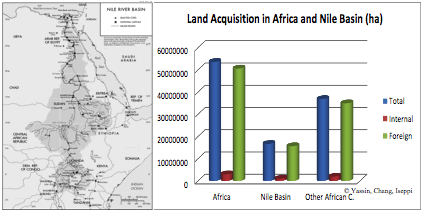
Fig. 1. (left) Nile River Basin map; (right) Land acquisition in Africa and Nile Basin (ha)
Source: World Bank; Our Estimations and Elaboration on Land Matrix Data respectively (accessed on 1st September 2013)
In Fig. 2, the total investment in land acquisition has been evidenced as significant proportion within Africa areas and among different contracting phases: Intended, Contracts, Pending Contracts (under negotiation) and Failed deals. The degree of failure is revealed to be very low in Nile Basin as well as in Africa.
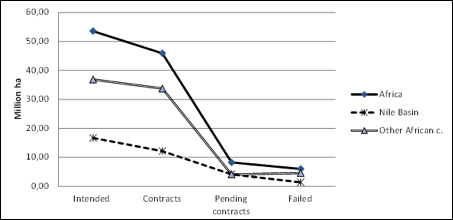
© Yassin, Chang, Iseppi
Fig. 2. Total investment in land acquisition in Africa and in the Nile Basin
Source: Our Estimations and Elaboration on Land Matrix Data (accessed on 1st September 2013)
This eminently theoretical paper is intended to highlight the emphasis and the need of paradigm shifts. From single resource grabbing focus to a more complex tangible and intangible vision of embedded resources focus. For instance, the territorial grabbing implies a biocultural grabbing, which can be verified through the technique of the biocultural fingerprint (Chang, Iseppi, 2011a).
Specifically, at this research stance, the major objectives of this paper are the following: i) to highlight the emphasis and the need of paradigm shift from single resource grabbing focus to a more complex tangible and intangible embedded resourcesvision; ii) to better understand the recent situation of Resources grabbing in the Nile Basin; iii) to determine the type of investigation needed and underline the necessity of accurate examination through a possible appropriate model capable to address the challenges related to the resource grabbing in the Nile Basin context.
Frequently the major actors behind the resource grabbing are stemming from post-industrialized countries, highly industrialized and/or industrializing countries, states with excess of financial sovereign funds, multinational corporations, and least but not last, wealthy international and local entrepreneurs. These actors are seeking large scale arable lands with certain fertility status, in proximity of water resources, cheap labour costs, growing demographic trends, combined with future potential profitable business opportunities in non saturated marketswith propensity of the proper governments to enter in partnership and encourage such investments with ad hoc sustaining investment encouragement acts revealed to be widely unsustainable.
Resource grabbing is linked to the technological status of the investor countries as well as that of target countries. Oftenly, these investors are proposing their technological advancement, as they need to market their production in the targeted countries. That occurs through facilitated sells, long-term loans, instalment payments and evenly sometimes using the barter system for guaranteeing the production of raw materials. That chaffer generates a sort of technological dependence.
In their propensity to attract foreign direct investments and to reduce the entry barriers, normally, the Nile basin countries enact encouragement regulations tending to oversimplification of investors entry in the interested country. In most of the cases, the grabbing actors assist in designing and drafting the investment encouragement act and the related legislations framework in a way that benefits their unannouncedfuture aspiration. Thus, interfering in the regulations, legislations, laws and norms and traditions and customary laws, which govern the resource ownership and land tenures. That form of hidden collusion is hard to verify. Governments tend to attract as much as foreign direct investments (FDI) to boost their economic and financial capacities. If the investments resulted in depriving the local communities from their resource ownership, it would have reverse effects and would result in major negative socioeconomic impacts to be mitigated. As these investments are intended to boost the development and well-being of the local population in a context of win-win model, there are no clear and striking evidences of that reciprocal and mutual beneficiary relationship, since there is neither significant poverty reduction nor clear improvements in the living conditions registered in the vast majority of that resource-grabbed territories. Unfortunately, often these investments in forms of FDI remain circulating in twisted clubs of elites and influential personalities without dissemination or diffusion to the targeted populations. Therefore, the model tends to be win-lose (development-involvement) and people in the Nile Basin remained in their squalor.
The lack of transparency and accountability in the natural resources management systems, the misuse of the collected capitals and the consequently resulted misinvestments in terms of misplacement, coupled with underestimation of real costs for the investors and overestimation of gains for the target countries and the widely diffused corruption of the variegated actors involved render this tangible natural grabbing a huge challenge to be addressed by the local communities, something which falls beyond their singular capacities especially under powerful and oppressive governments which tend to exclude their opponents and practice undeclared fight against the local opposing leadership.
Instead of LandGrabbing, the phenomenon is then definable as Resource Grabbing. Effectively Land, Water, Forest, and Air/climate and biodiversity Grabbing is a complexbundle as explained and represented in Sketch 1.
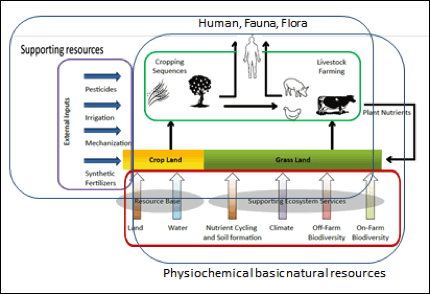
© Yassin, Chang, Iseppi
Sketch 1. Complex Resources, “Principal resource flows and ecosystem services supporting Agricultural system”. Adapted from the UNEP 2012 Report.
Some organizations and scholars argue that land grabbing is a pattern of new colonialism (Liberti, 2011), and recently resource grabbing has gained and will increase its gained momentum. In an era of much-polluted planet, the adaptation and adoption of the renewable resources path is revealing to be compelling and stringent need. In this context, the Carbon sequestration and credits trading is expected to high rocket. In particular, the biochar, which is a soil-amending element and recently traded and considered as a possible multiple win domain. In the Nile Basin context, there are no striking evidences of that unless it is set in a form that considersnecessary designing appropriate strategies of waste-based systems, thus transforming the potentially wasted resources in economically viable, socially equitable and environmentally sound opportunities. The carbon grabbing will be explained in a wider extend since it is relative a novel.
Changing the paradigm from land to resource grabbing and Resource Grabbing Conceptualization
Land grabbing occurs when land that was previously used by local communities is leased or sold to outside investors, including corporations and governments. Traditionally, Land grabbing cannot be considered a new phenomenon. For centuries, communities have been intimidated to abandon or have been forcibly removed from their land. Under the Kyoto Protocol, one can argue on the Green grabbing in which most advanced countries are allowed to offset their carbon emissions by buying carbon credits; in USA this happen through the participation in projects allocated in the developing world: the so-called Clean Development Mechanism (CDM). These credits or allowances can then be traded on carbon markets (European Union, 2008). Typically, the resources such as lands are taken over for commodity crops to sell on the overseas market, including for agro-fuel and food crops. However, land grabbing alsooccurs to clear land for tree plantations (grown for carbon offsets), protected reserves, mines and can often result from speculative investments when funds predict a high rate of return from land investments. Thus, when apparently only lands are subjected to grabbing, it include embedded a lot of resources, ranging from water, valuable nutrients, minerals, carbon sequestration capacities as well as non tangible dimensions such as the local cultural heritage in addition to the human capital indigenously inhibiting that lands. Not least the in-farm and off-farm biodiversity. Substantially, resource grabbing goes beyond the tangible resources. Therefore, it can be mentioned and highlighted that resource grabbing influence not only the human, fauna and flora in the interested territories, but all the complexity of resources embedded in those territories. It includes, land, water, climate, biodiversity underneath the soil, on the soil, and over the soil. As land grabbing also the resource grabbing is not a new phenomenon. Nonetheless, recently new aggressive and complex resource grabs are witnessed, driven by high food prices and growing global consumption, with multinational corporations often in partnership with governments, seizing the lands, waters, forests, natural minerals and incorporated with them common goods and the associated services (Chang, Iseppi, 2011b; 2012). Therefore, resources grabbing can be considered as multidimensional and multidirectional phenomenon in terms of time and space. As a consequence, vulnerable peasants, herders, fishers and rural households especially in low income countries are being dispossessed of the means to feed themselves andtheir communities; local populations are being evicted and displaced, humanrights are being violated, and the environment, as well as traditional community structures, is being compromised. Resource grabbing mainly refers to situations where powerful multiplayer actors disproportionally manage to benefit and take control of or divert valuable tangible, visible, hidden, embedded and intangible resources for their own benefits leaving the local and traditional owners with little and insignificant benefits and great long term losses. Meanwhile, favouring selfish and colluded actors, and consequently depriving, displacing and destabilizing local communities and jeopardizing their essential livelihoods and depredating the ecosystems necessary for their sustainable living.
Misuse, mismanagement and misinvestments concepts
Resource use and management are clear and straightforward practices undertaken by actors to maximise the utility of the exploitation of the resource base and the annexed natural resources. That can be explained in the proper use of lands, waters, forests, fauna and flora as large, while the management practices occur when business activities are run by actors in organized and coordinated patterns in pathways seeking maximization of profits and minimization of incurred cost, in addition to the merely natural resources, it involves the exploitation of the mechanical equipments and/orHuman labour and intellectual capabilities. Instead, the investments often are tied with attraction of financial capital and know-how needed to up-and-out-scale and up-grade the exploitation of the resources to generate employment, income, profits…etc.
In the Nile Basin context, frequently these investments are tied to foreign investors or locals-tied-to-foreign investors. The distribution among Nile Basin countries demonstrates the prominence of South Sudan with above of 30% both for intended and concluded contracts (Fig. 3) followed by Congo D.R., Sudan and Ethiopia. The pending contracts under negotiation prevail in Sudan, Uganda, South Sudan and Ethiopia. The vast majority of the failed contracts are witnessed in Sudan followed by Kenya likely due to institutional complications.
Fig. 4 shows the distribution of Land acquisition by country within the Nile Basin in which the former Sudan shares almost half as well as for the contracts. This implicates complication following the South Sudan independence (July 2011) because thedeals were negotiated before. Land matrix recalculation was done only on geographical allocation of the land rather than its geo-political ownership. The resource grabbing is a tool of political destabilization.
© Yassin, Chang, Iseppi
Fig. 3. Nile Basin: Estimated Land Acquisition
Source: Our Estimations and Elaboration on Land Matrix Data
(Accessed on 1st September 2013)
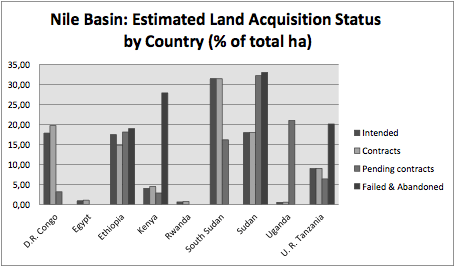
© Yassin, Chang, Iseppi
Fig. 4. Nile Basin: Distribution of Intended and Contracted Land Acquisition by country
Source: Our Estimations and Elaboration on Land Matrix Data
(Accessed on 1st September 2013).
Ideally, that investments are intended to be reciprocally beneficial to the local and foreign investors, however, when the gain and loss tends to occur on only some ends and the others remain deprived, that is what could be denominated misinvetments. It is characterized with lack of shared benefits and lesser risks to the investors than the original owners of the resources. Therefore, misinvestments are harmful for at least one end of the investment chain and apparently beneficial to the other end in the short run. Clearly, in the long term, that misplaced investment and inappropriateallocation of resources, results harmful for both the recipient territories and the investing actors. As the misuse and abuse of resources by the variegated mismanaging actors results in conflicting business and generates gloomy business environment, in the long run, the consequence of that is missing or bad-practices results in disinvestments for the investors and loss for the hosting territories thus leading to divestments and consequently results as misinvestments.
Land grabs: development or involvement?
Land deals are very large in scope and take up fairly high percentages of the existing land resources in the host Nile Basin (NB) countries. It has impacts such as changing the cultivation patterns to agricultural intensification, desertification, soil and forest degradation, displacement of local populations, increasing local food insecurity and increasing poverty (e.g. the case of Kordofanian and Blue Nile territories in Sudan). In reality the necessity to intensify the agricultural production and the conservation of the agro-forestry ecosystem are two contrasting points; the founding element is the hydrological cycle alteration (Garlaschini, Calcaterra, 1999, p. 96).
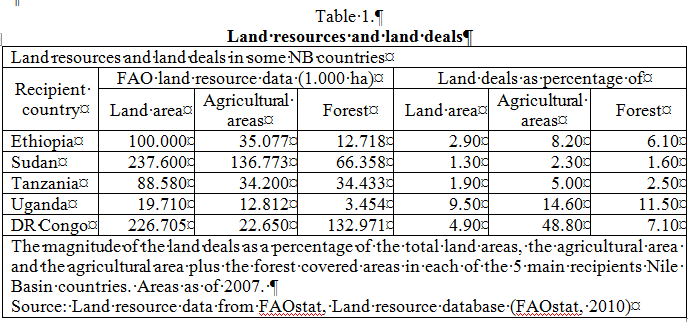
The magnitude of the land deals as a percentage of the total land areas, the agricultural area and the agricultural area plus the forest covered areas in each of the 5 main recipients Nile Basin countries. Areas as of 2007.
Source: Land resource data from FAOstat, Land resource database (FAOstat, 2010)
Yet, consistent information about the final goal of investment in the different recipient countries is lacking (misinvestment and disinvestment). Deals in Ethiopia represent a far greater percentage of the agricultural area, and might lead to larger impacts on the local population in the country in the long run (Table 1).
Land grabbing as well as resource grabbing is directly associated with hunger prevalence. Sometimes the grabbing countries are grabbed country at the same time (e.g. Egypt). Note that there were successive and protracted hunger in the recent decades aggravated by up surging of recurrent land and resource grabbing in the Nile Basin (Fig. 5).
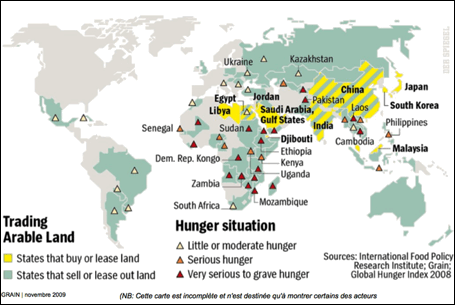
Fig. 5. Trading Arable Land and Hunger situation
Source: IFPRI (2008) and Grain (2009).
Carbon credit in climate grabbing context
The carbon markets were instituted in 1997 by the Kyoto Protocol, which has imposed, in all industrialized countries adherents, to reduce the GHG emissions and to stabilize its concentrations in the atmosphere. This is intended for climate change mitigation and adaptation. The Carbon Market is a place where buyers and suppliers of carbon credits from industrialized countries (or companies within these countries) and sellers even from developing countries (or projects within them) meet, negotiate, exchange, seal deals and/or stipulate contracts (Sketch 2.). The carbon credits are sold as financial instruments on the carbon market and allow GHG emitting countries(generally post and industrialised countries) to offset their climatic pollution through presumed clean and renewable energy projects to be implemented prevalently in developing countries (Kettner et al., 2012). Over the years, this market has become a huge business. At present, the price value of carbon credits in the EU amounted to € 4 per ton while in Africa it is not yet clearly determined and need to be investigated. Prior to the global financial crisis (2007-8), some projections estimated that in EU the price per ton would reach € 30-40 by 2030. Carbon trading is a growing market; in January 2011, the global market was worth € 96 billion, with approximately 8.4 billion tonnes of carbon dioxide traded. This represents a 4% increase in value respect the previous year and a 19% cent increase in traded carbon dioxide (IETA, 2012). There is not transparent figures and clear picture depicting the carbon trading in Africa above all within the Nile Basin where climate grabbing is assumed to take place. For instance, in the United States more than 48,000 farms are selling carbon credits through The International Small group and Tree planting programme (TIST). Besides, the World Bank’s Carbon Finance Unit’s Bio-Carbon Fund, has developed a new soil carbon methodology approved by the Verified Carbon Standard. There are neither striking evidences nor concrete mutuallybeneficial business opportunities that the Nile Basin is sustainably included and benefiting from that world financial setting. Thought this methodology ought to help farmers adopt practices that build up the soil’s organic matter, increasing its resilience to climate change effects, store more carbon in the ground (Ventures, 2012) and eventually allowing the farmers to earn carbon credits.
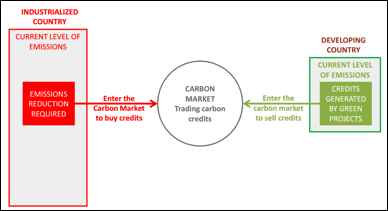
Sketch 2. Structure of the carbon markets. Source: Chingambo, 2012.
It is a sort of business as usual in the sense that the significant decisions are made by rich countries that pollute, while those who should break down the carbon footprint are actually the countries with low per capita income, but especially forestry resource-rich. Instead of striving to reduce GHG emissions, as required by the Kyoto Protocol, in countries where it is generated, these actors unload the burden on others using the same technique adopted by free riders. The technical-legal tool used is to acquire land abroad through direct investment so grabbing all the tangible and intangible resources involved in contracts including those relating to carbon credits. The theoretical framework of reference is the win-win model, but investors are well aware that less advantaged countries lack cohesion and miss a common policy. Therefore game theory effect of “prisoner’s dilemma” takes over and, in the fear to be damaged, each actorseparately agrees with the counterparty (foreign investors) thus creating maximum damage to him/herself and to other stakeholders. The tricky lesson does not yet seem to have been understood by target countries although for example some glimmer of idea seems to emerge from the newly formed association Africa countries in the AU 2063 Agenda with renascence visioneering.
CONCLUSIVE REMARK
In win-win model is important the distribution of gains between domestic actors and foreign investors. The common pool of resources should be protected against harmful grabbing practices, well used, consciously managed and fairly exploited by suitable investors. By that, these commons can play a considerable role in upgrading the food and nutrition security, reducing extreme poverty, guaranteeing healthy and qualitative life standards. Furthermore, it will be useful in mitigating the negative externalities of the current and future climate changes affecting the local communities along the Nile Basin and beyond. Is this utopia? Rigid planning discourages foreign investors while no rules create dystopia. The importance of Regional cooperation over the Nile Basin as common-pool of resources far outweighs the potential conflicts over the very resources. Almost, what is needed is more regional integration spirit in sense of liberation, mobility and mobilization of social capital and better and equitable distribution of wealth and common resources from within the basin territories, above all the common water. That might seem Utopia, but realistically speaking and considering the exemplar experiences of the Danube and Amazon Basins, one can realize that the major success factor in that territories were the shifts from overwhelming conflictive atmosphere towards cooperative approaches. If the Game theory its prisoner’s dilemma is taken in consideration, it could be easily approvable that the fair competition and cooperation is a winning approach. That implies creations of common platforms stemming from the local, to regional, national, transnational long-term planning and strategic visioneering.
Summary
The major causes of this resource grabbingmarathon are attributable mainly to issues related to: a) food and nutritionsecurity; b) climate change adaptation and mitigation; c) energy and water security; d) demographic instability, e) social and economic needs, f) ecological foundation, and g) regional polarization, among others. Doubtless, resource grabbing will lead to non-sustainability in the sense that it deprives the interested population from their fundamental human rights and well-being. It will compromise the ecosystems integrity and basic capacities needed to sustain the human, fauna and flora in the Nile Basin. It has dramatic future consequences in terms of climatic and environmental dimension, social cohesion, political stability, and cultural heritage depletion, community economic resilience, appropriate governance and loss of developmental paths.
Acknowledgements
The lead author would love to acknowledge the helpful support provided by the University of Udine, IPSAPA-ISPALEM, University of Padua-CIRVE, the anonymous referees for their invaluable comments and advice. Dr. A. Babiker for read prove, and Dr. S. Clocchiatti for data collection and organization.
References and Websites
1. Chang T.F.M., and Iseppi L. (2011a), La fingerprint bioculturale: concetto ed evoluzione nel caso italiano, in “La fingerprint bioculturale del Friuli Venezia Giulia. Esperienze aziendali delle microfiliere di qualità” a cura di Chang T.F.M., Piccinini L. C., Schenkel M., pp. 75-85, Forum, Udine.
2. Chang, T.F.M.; Iseppi, L. (2011b). Specialization versus Diversification in EU Economies: a Challenge for Agro-food? , Transition Studies Review, 18, 1, 16-37.
3. Chang, T.F.M.; Iseppi, L. (2012). EU Agro-Food Chain and Vertical Integration Potentiality: a Strategy for Diversification? Transition Studies Review, 19, 1, 107-130.
4. Chingambo L. (2012). ACCE as a Vehicle for Boosting Investments in Forestry, Forest Carbon and Renewable Energy. Accra, Ghana.
5. European Union (2008). EU Actions against climate change. The EU Emissions Trading System (EU ETS), Luxembourg, January.
…
